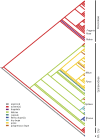Multiple models for Rosaceae genomics
- PMID: 18487361
- PMCID: PMC2442536
- DOI: 10.1104/pp.107.115618
Multiple models for Rosaceae genomics
Abstract
The plant family Rosaceae consists of over 100 genera and 3,000 species that include many important fruit, nut, ornamental, and wood crops. Members of this family provide high-value nutritional foods and contribute desirable aesthetic and industrial products. Most rosaceous crops have been enhanced by human intervention through sexual hybridization, asexual propagation, and genetic improvement since ancient times, 4,000 to 5,000 B.C. Modern breeding programs have contributed to the selection and release of numerous cultivars having significant economic impact on the U.S. and world markets. In recent years, the Rosaceae community, both in the United States and internationally, has benefited from newfound organization and collaboration that have hastened progress in developing genetic and genomic resources for representative crops such as apple (Malus spp.), peach (Prunus spp.), and strawberry (Fragaria spp.). These resources, including expressed sequence tags, bacterial artificial chromosome libraries, physical and genetic maps, and molecular markers, combined with genetic transformation protocols and bioinformatics tools, have rendered various rosaceous crops highly amenable to comparative and functional genomics studies. This report serves as a synopsis of the resources and initiatives of the Rosaceae community, recent developments in Rosaceae genomics, and plans to apply newly accumulated knowledge and resources toward breeding and crop improvement.
Figures



References
-
- Aharoni A, Keizer LCP, Van den Broeck HC, Blanco-Portales R, Munoz-Blanco J, Bois G, Smit P, De Vos RCH, O'Connell AP (2002) Novel insight into vascular, stress, and auxin-dependent and -independent gene expression programs in strawberry, a non-climacteric fruit. Plant Physiol 129 1019–1031 - PMC - PubMed
-
- Aharoni A, O'Connell AP (2002) Gene expression analysis of strawberry achene and receptacle maturation using DNA microarrays. J Exp Bot 53 2073–2087 - PubMed
-
- Akiyama Y, Yamamoto Y, Ohmido N, Ohshima M, Fukui K (2001) Estimation of the nuclear DNA content of strawberries (Fragaria spp.) compared with Arabidopsis thaliana by using dual-step flow cytometry. Cytologia (Tokyo) 66 431–436
Publication types
MeSH terms
LinkOut - more resources
Full Text Sources
Other Literature Sources
Research Materials
Miscellaneous

